The Xiaomi 11T & 11T Pro Review: Two Chips, With a Battery Focus
by Andrei Frumusanu on September 15, 2021 9:00 AM EST- Posted in
- Mobile
- Smartphones
- Xiaomi
- Xiaomi 11T
- Xiaomi 11T Pro
System Performance
The comparison of the Snapdragon 888 to the Dimensity 1200 is interesting as we don’t tend to get to compare MediaTek devices very often. In theory, the Snapdragon has much more oompf to it given its higher performance X1 core, but things also depend on software.


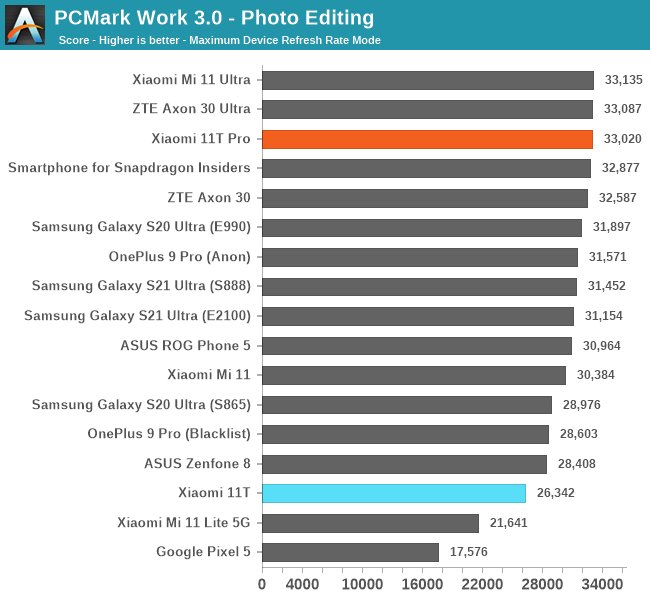
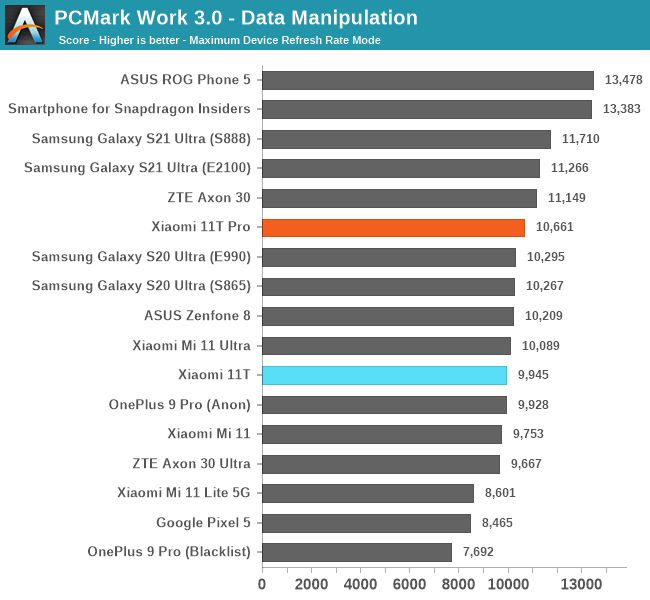
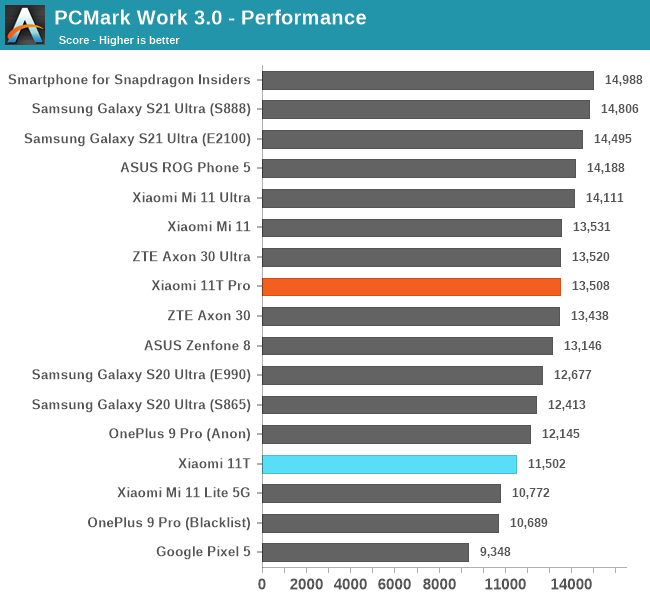
In PCMark, as expected, the Qualcomm powered 11T Pro has no issues in performing quite ahead of the MediaTek powered 11T. It seems that the SoC as well as software stack allows for more aggressive responsiveness on the larger SoC – which is to be expected.
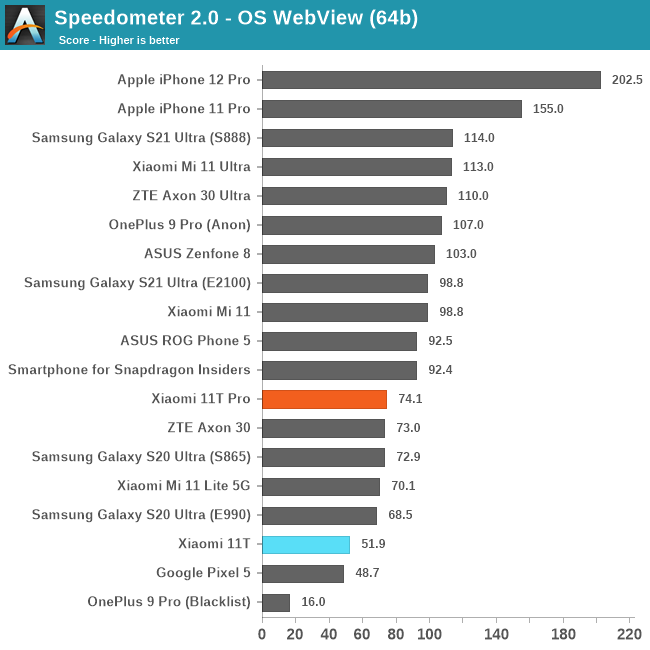
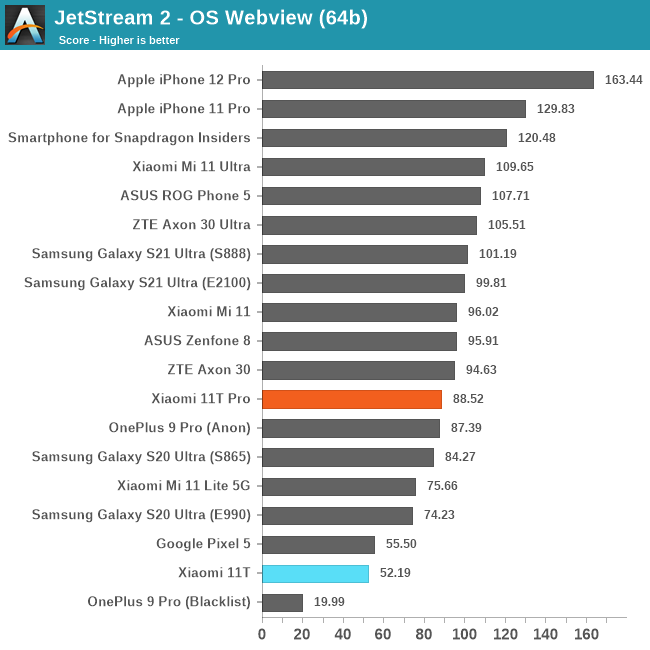
When it comes to the web tests, we also see the 11T Pro easily outperform the 11T, by quite some significant margins even.
What’s a bit weird here is that both devices are actually performing below expectations, and here is where things get very shady:
The Snapdragon 888 in the 11T Pro in these benchmarks is never using the Cortex-X1 cores of the SoC. Instead, pretty much the totality of the tests is being performed on the 2.41GHz A78 cores. If this sounds familiar to you, it’s because we saw some kind of similar behaviour on the OnePlus 9 Pro.
What’s happening on the 11T Pro is that indeed it seems any anonymous workload on the phone is mostly unable to be scheduled on the X1 cores, unless there’s multiple threads which causes spill-over. Without CPU affinity in my SPEC harness, the load gets also scheduled on the A78 cores. If I limit it to just the X1 core, it only goes up to 2.15GHz. In GeekBench, the ST workloads do go up to 2.84GHz even in an anonymised variant of the test, however in the MT load the X1 cores again are limited to 2.15GHz. The X1 cores are still being used here and there in scenarios such as opening apps, but otherwise rarely so.
I can’t really tell if it’s extreme battery optimisation or not, but it’s quite aggressive and the Snapdragon 888 here is definitely handicapped in terms of behaviour.
On the MediaTek Dimensity 1200, the chip fares normally in steady state workloads, however in more interactive workloads such as the above web tests, the DVFS and scheduling behaviour is all over the place with the chip not consistently having the workload on the performance core. I’m also seeing bursts of the other cores needlessly going up in frequency. In general, we don’t have too much experience with MediaTek’s latest software stack, so this would require a bit more investigation, but generally, the phone doesn’t perform quite as well as the raw CPU performance would indicate.
Both phones are fluid at 120Hz, and the 11T Pro is still very responsive, however the 11T doesn’t feel quite as fast.










41 Comments
View All Comments
zodiacfml - Wednesday, September 15, 2021 - link
not only does 120w charging is crazy, it also appears to charge at a high rate even at 80% battery state. tricks I know is to use two batteries in series and using larger capacity batteries than advertised or lower voltage cutoff. however, those tricks don't appear enough to get up to 120w.yetanotherhuman - Thursday, September 16, 2021 - link
It'd be nice to see some phones again one day, and not just phablets.Linustechtips12 - Thursday, September 16, 2021 - link
very much agreed I will not ever go for an iPhone sorry... but I want the size in between something like the 13 mini and the regular 13 or just a smidge smaller than the s21, the s21 is actually almost perfect coming from an s10e I hope the overall size of the 22 is slightly smaller or the same size as the s10eTheinsanegamerN - Friday, September 17, 2021 - link
So, on a phone like this, how would that work with US carriers? It's not officially sold here, will it work with VoLTE or will these phones be bricks once the 3G networks go down?ATT and verizon are very picky about what is allowed, and while most US sold phones are supported they say nothign about xaiomi.
coolkwc - Sunday, September 19, 2021 - link
If you ever own a fast charging phone and power meter, you will know the 'algorithm' behind the fast charging. The charge current is reduce in staggered, however from what i saw, it is based on temperature capped rather than preset according to SoC. You will noticed that it will reduce the charge in order to keep temperature under 40'C. So if your phone temperature is at the high side when you plug in the charger, the fastest charge rate will not even activated/sustained for any longer, however it will sustain longer if the charge temperature is low. I'm using the Mi 11 Ultra with 67W charger, to preserve the battery life i normally charge using my old QC3.0 samsung charger at home and only charge until 4.3V which is 85-90% full, the sustain charge current is at around 3.5A for the whole charging period. The bundle 67W Xiaomi charger serve as my quick 'travel' charger where i will use when i need a fast top up, which not often based on my use case.Plumplum - Monday, September 20, 2021 - link
Installation of monitoring apps can show problems with CPU behavior...why wasn't it done on the first test?ROM was responsible of the problem.
Problem with Anandtech is how fast they're to accuse Mediatek without asking them questions on how the device and sometime some benchmarks (such as PCMark) behave.
That was already the same with so called cheating.
Unfortunatelly post people won't read the corrected article. The damage is done!
Should made a separate article to apologize!
Premade thought leads to unfair review.
iphonebestgamephone - Saturday, September 25, 2021 - link
Nothing was wrong in cheating one back then. Mediatek not including the cheat mode in dimensity should be enough to tell you all about it.xol - Monday, September 20, 2021 - link
Hot take 1The Cortex X1 is a bad core. Not bulldozer bad but pentium hot/bad/inneficient, which is doubly bad in a mobile environment. ARM added lots of cache and didn't add enough functional units to make it worthwhile. It's half the M1 design - all the cache but lacks the pipeline. bad.
Hot Take 2
Manufacturers (qualcom/xiaomi) know this but can't avoid using latest/"best" core in their latest designs because product spec sheets > actual real world utility.
Hot Take 3
Manufacturers know this too (hot take 2) but still need to use the "bad" X1 cores in their flagships because they need to be "flagship". But the core is crappy and give bad battery life. So they're compensating by essentially disabling as much as they can. (pretty much fact and not hot take)
A ide Hot Take 4
Snapdragon 888 is a "bad" chip too, and not just the X1 core, also the GPU. Quallcomm use the node advantage (5 vs 7nm) to squeeze extra frequency out of their designs, They claim +50% ALU in the new chip (vs 865) but/and clock it at 840 vs 650MHz (+29%). But performance is only +25%. There's real world evidence that the 888 runs hot and thermally throttles in phones way earlier than 865, despite being on 5nm -
sweetca - Tuesday, September 21, 2021 - link
I prefer my spying domestic.Yourdailytask - Thursday, September 23, 2021 - link
hello admingrate post